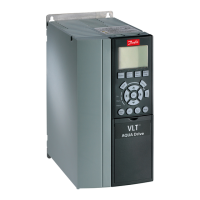[4] Quick stop inverse Inverted input (NC). Generates a stop in accordance with quick-stop ramp time set in par. 3-81
Quick
Stop Ramp Time
. When motor stops, the shaft is in free mode. Logic ‘0’ => Quick-stop.
[5] DC-brake inverse Inverted input for DC braking (NC). Stops motor by energizing it with a DC current for a certain time
period. See par. 2-01
DC Brake Current
to par. 2-03
DC Brake Cut In Speed [RPM]
. The function is
only active when the value in par. 2-02
DC Braking Time
is different from 0. Logic ’0’ => DC braking.
[6] Stop inverse Stop Inverted function. Generates a stop function when the selected terminal goes from logical level
‘1’ to ‘0’. The stop is performed according to the selected ramp time (par. 3-42
Ramp 1 Ramp Down
Time
, par. 3-52
Ramp 2 Ramp down Time
, par. 3-62
Ramp 3 Ramp down Time
, par. 3-72
Ramp 4
Ramp Down Time
).
NB!
When the frequency converter is at the torque limit and has received a stop
command, it may not stop by itself. To ensure that the frequency converter stops,
configure a digital output to
Torque limit & stop
[27] and connect this digital
output to a digital input that is configured as coast.
[8] Start (Default Digital input 18): Select start for a start/stop command. Logic ‘1’ = start, logic ‘0’ = stop.
[9] Latched start The motor starts, if a pulse is applied for min. 2 ms. The motor stops when Stop inverse is activated.
[10] Reversing (Default Digital input 19). Change the direction of motor shaft rotation. Select Logic ‘1’ to reverse.
The reversing signal only changes the direction of rotation. It does not activate the start function.
Select both directions in par. 4-10
Motor Speed Direction
. The function is not active in process closed
loop.
[11] Start reversing Used for start/stop and for reversing on the same wire. Signals on start are not allowed at the same
time.
[12] Enable start forward Disengages the counterclockwise movement and allows for the clockwise direction.
[13] Enable start reverse Disengages the clockwise movement and allows for the counterclockwise direction.
[14] Jog (Default Digital input 29): Use to activate jog speed. See par. 3-11
Jog Speed [Hz]
.
[15] Preset reference on Shifts between external reference and preset reference. It is assumed that
External/preset
[1] has
been selected in par. 3-04
Reference Function
. Logic '0' = external reference active; logic '1' = one
of the eight preset references is active.
[16] Preset ref bit 0 Preset ref. bit 0,1, and 2 enables a choice between one of the eight preset references according to
the table below.
[17] Preset ref bit 1 Same as Preset ref bit 0 [16].
[18] Preset ref bit 2 Same as Preset ref bit 0 [16].
Preset ref. bit 2 1 0
Preset ref. 0 0 0 0
Preset ref. 1 0 0 1
Preset ref. 2 0 1 0
Preset ref. 3 0 1 1
Preset ref. 4 1 0 0
Preset ref. 5 1 0 1
Preset ref. 6 1 1 0
Preset ref. 7 1 1 1
[19] Freeze ref Freezes the actual reference, which is now the point of enable/condition for Speed up and Speed
down to be used. If Speed up/down is used, the speed change always follows ramp 2
(par. 3-51
Ramp 2 Ramp up Time
and par. 3-52
Ramp 2 Ramp down Time
) in the range 0 -
par. 3-03
Maximum Reference
.
[20] Freeze output Freezes the actual motor frequency (Hz), which is now the point of enable/condition for Speed up
and Speed down to be used. If Speed up/down is used, the speed change always follows ramp 2
(par. 3-51
Ramp 2 Ramp up Time
and par. 3-52
Ramp 2 Ramp down Time
) in the range 0 -
par. 1-23
Motor Frequency
.
4 How to Programme
VLT
®
AutomationDrive FC 300 Operating
Instructions
60
MG.33.AG.02 - VLT
®
is a registered Danfoss trademark
4

